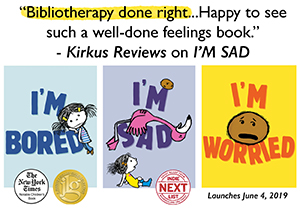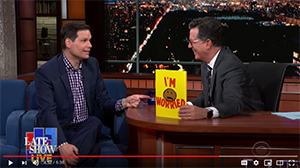Posts so far: Main Index/Resources -Part 1 - Part 2 - Part 3 - Part 4
Back to Where Are My Books? Bonus Page

One of the motivations for writing WHERE ARE MY BOOKS? was a blank contract I signed in 2012. For those not familiar with the term, a blank contract is a sign of faith from the publisher in an author and/illustrator. Have to admit I was both flattered and nervous about accepting an advance for a book I hadn't yet written or illustrated.
I am grateful to Justin Chanda and Simon & Schuster Children's for not only giving me my first big break in children's publishing, but also continuing to believe in me.
I've been posting sporadically about the early stages of the process over on Inkygirl.com but now that I actually have a TITLE for the book, I've decided to revamp the posts for the WHERE ARE MY BOOKS? Bonus Page.

The first step:
I brainstormed picture book ideas.
I've been compiling picture book ideas for a while now, inspired by Paula Yoo's NaPiBoWriWee, Tara Lazar's PiBoIdMo and #KidLitArt's Picture Book Dummy Challenge. I've turned some of these into picture book manuscripts. WHERE ARE MY BOOKS? began as a single line that I scribbled as one of my ideas during PiBoIdMo. At the time, I had no idea that it would eventually turn into my first solo picture book.
 What I discovered: it's easy to come up with ideas for books. The challenge: to come up with book ideas that are different from anything else already out there.
What I discovered: it's easy to come up with ideas for books. The challenge: to come up with book ideas that are different from anything else already out there.
This is one of the common misconceptions held by newbie picture book writers, I find: that their story is unique. I still consider myself a newbie picture book writer, by the way, so I speak from experience.
Child nervous about their first day at school but then finds out another child feels the same / makes new friends / discovers it's not so bad after all? Done.
Child has trouble making new friends because they are too shy / insecure / mean / stubborn / family just moved? Done.
 Child loses a beloved object / pet / toy and is totally distraught but then formulates plan / enlists help / searches everywhere? Done.
Child loses a beloved object / pet / toy and is totally distraught but then formulates plan / enlists help / searches everywhere? Done.
Child having a horrible day where nothing goes right but then takes action & everything turns out ok? Done.
Child resents the fact that he is always overlooked / ignored and decides to do something about it? Done.
Child hates doing something that parents always want her to do so finds a way around it but then discovers why it was a good idea? Done.
Child resents older or younger sibling so decides to run away / get rid of sibling somehow but starts missing the sibling despite himself and reunites? Done.
Child...well, you get the idea.

The bottom line: It's very tough to come up with a story that is totally unique.
But still:
I tried to figure out how to make my story stand out in the marketplace.
At this point, I can already imagine some of you shaking your fingers at me and saying, "Just focus on making a good story. Worry about the marketing/publishing part later."
However, I'm already assuming that having a good story is an essential. My end goal, however, is to not only get the book published but to have the book sell well. If the story is too much like others already out there, a publisher is less likely to want to take a risk on it. And if the book doesn't sell well, then the publisher is less likely to offer me more contracts.

So yes, there needs to be a good story BUT I also want to help an editor convince their sales team that the book should be published.
An aside: I've already gone through this several times with my novels for young people, in which various editors liked my story enough to take to the next step, but then the projects were nixed by sales/marketing. It's one reason I spent way more time in the plotting/outlining process for my current YA mss before starting to actually write it (and it got nominated for an SCBWI Sue Alexander "Most Promising For Publication Award"! It didn't win...but still! Now I just need to finish it).
So yes, I was discouraged. But then I thought, hold on. Surely I can't be the only one despairing about finding a unique story idea. And there are new picture books coming out all the time!
And that brings to me to another essential part of my "newbie picture book writer/illustrator" self-education:

I read many, many picture books.
Since the career-changing events of 2010, I've been immersing myself in the world of picture books. I have no children and hadn't really read many picture books since my nephews and nieces grew past that stage.
Once Simon & Schuster BFYR offered me my first picture book illustration contract, that all changed. I started going to the library and local bookstores every week to read as many picture books as I could. I read everything I could get my hands on -- old and new.
I looked at both the text and the illustrations, and how they enhanced each other. I didn't always like the picture books I read, but tried to analyze exactly WHY I didn't like them. And when I really enjoyed a picture book, then I'd reread it and ask myself similar questions: WHY did I like it?
I needed to figure out a unique spin for my stories.
I looked especially closely at new releases. Obviously these publishers had faith in these books, so what was it about the stories that made the publishers willing to invest money into these projects? The answer: a unique spin. In almost every case, the basic story was enhanced with a framework made unique in either the setting, characters, voice, format or other aspect.
Once I realized this, I went over my list of picture book stories and started working on expanding some of them into full manuscripts with the whole "unique spin" aspect in mind.
But still, I wasn't completely happy with any of them yet.
I realized that I needed to get my head into "pitch" mode.
 When I last visited Simon & Schuster BFYR in NYC to talk about I'M BORED promotion, Justin asked me if I had any picture book stories to show him. I hesitated, saying that I had written about 25 picture book manuscripts but wasn't yet happy with any of them.
When I last visited Simon & Schuster BFYR in NYC to talk about I'M BORED promotion, Justin asked me if I had any picture book stories to show him. I hesitated, saying that I had written about 25 picture book manuscripts but wasn't yet happy with any of them.
Justin interrupted my babbling excuses and suggested that I needed to change my mindset. Having worked with S&S BFYR on I'm Bored, I already had my foot in the door. Simon & Schuster Books For Young Readers was my publisher. He was my editor. So how about I pick out 4-5 of what I considered my best stories and send them to him, even if I didn't think they were perfect yet?
Whoa. Really?!?
Ok, I admit I was pretty clueless. I had figured that even though I had illustrated a book for S&S BFYR, that I was still starting from scratch when it came to submitting my own stories. And that if they said no, that was it.
I was wrong.
Anyway, I promised Justin I'd send something very soon. Of course I was STILL paranoid about sending stories that I considered early drafts, so I enlisted the help of my MiG Writers critique group for some feedback and suggestions for tweaks.
Then...I took a deep breath and send my stories to Justin.
He picked one he thought had the most potential. I'm very happy he picked the idea that he did; of all the stories I sent him, this is going to be the most fun to draw!
We had a phone meeting about my story, with editorial assistant Dani Young sitting in. It was a TRULY EXCELLENT phone meeting. I was all "omigod, you're absolutely RIGHT" and "YES! I love that!!" and Justin was all "it's all right there in your story" (I just hadn't seen it).
What Justin was able to do, which I hadn't, was to identify the essence of my picture book as well as see the potential of what it could be. AND he was able to communicate that to me.
By the end of the phone call, I was incredibly inspired and eager to get started.
Continued in Part 2 (Thinking visually with thumbnail sketch templates)
 Thursday, April 30, 2015 at 3:30PM
Thursday, April 30, 2015 at 3:30PM 







 pbcreation in
pbcreation in  Making Of A Picture Book
Making Of A Picture Book 


























